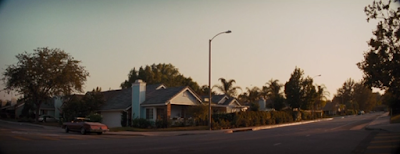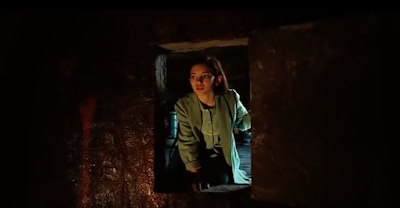La La Land
Discuss how important cinematography is in establishing strong responses from spectators to a key character in 'La La Land'- Must refer to a scene
 The scene opens up with Sebastian driving up towards Mia's family home to take her to the audition, this is shown through a wide shot (establishing shot) this allows the audience to identify the area and we also see a strong difference between audience, this means the audience would need to be more active so they are able to identify difference in setting and atmosphere comparing on being in the city compared to Mia's home town. With the establishing shot we are able to notice the orange and walk colour palette of Mia's home town, this gives a warm and calming kind of feeling and having the comfort of being somewhere, the audience, especially me would identify with this because it can show Mia enjoys the comfort of her own natural home and is family orientated by choosing to go back with her parents and spend time with them. It then cuts to a mid shot of the car when Sebastian pulls up to the house and waits for Mia he then begins to drive off but Mia appears out of nowhere, the camera then pans across where we see the two together however we are able to see strong tension between the two.
The scene opens up with Sebastian driving up towards Mia's family home to take her to the audition, this is shown through a wide shot (establishing shot) this allows the audience to identify the area and we also see a strong difference between audience, this means the audience would need to be more active so they are able to identify difference in setting and atmosphere comparing on being in the city compared to Mia's home town. With the establishing shot we are able to notice the orange and walk colour palette of Mia's home town, this gives a warm and calming kind of feeling and having the comfort of being somewhere, the audience, especially me would identify with this because it can show Mia enjoys the comfort of her own natural home and is family orientated by choosing to go back with her parents and spend time with them. It then cuts to a mid shot of the car when Sebastian pulls up to the house and waits for Mia he then begins to drive off but Mia appears out of nowhere, the camera then pans across where we see the two together however we are able to see strong tension between the two.

It then cuts to seeing the two in the audition office and we instantly see a change in colour scheme and shot appears to be smaller making the office and Mia and Sebastian the main focus, the camera almost looks like a fish eye lens as if the audience is looking through the door to see what is happening, this makes the audience feel more included, however the audience would be more active as they would have to notice the difference in atmosphere and how much the colour scheme. It presents the city scene with all the strong bright colours, it creates a more light-hearted atmosphere and we are able to reflect the mood and what is happening to the characters as the film is more explicit with its information. As Mia enters the audition room the camera instantly focus' on her on an extreme close up, this emphasises that this is Mia's special moment that can change and start up her career. As her audition begins the camera begins to zoom in on Mia as she starts her story/ audition, when she starts singing its a continuous shots without any cuts or editing as the camera only focus and moves around Mia. The only centre of lighting is on Mia in a representation of a spotlight on Mia, the audience will become passive in this moment as they don't need to focus on multiple things at once due to it being only a spotlight moment on Mia. The Spotlight is a popular lighting technique used throughout the film, this shows the difference between the real world and the fantasy world that Mia and Sebastian live in, the whole film of La La Land shows the difference between the fantasy world and reality showing the contrast of real life situations compared towards their superstar dreams.We are able to see the expression and the emotion throughout the song and tends to hold a deeper meaning than the other songs. The audience will feel more meaning and connection with Mia as she is talking about her family and struggles with her life to get to the point she is at now. The continuous shot around Mia emphasises the importance of Mia audition and how much this works and supports her future, for the audience they will feel relief for Mia as this is an opportunity to achieve her dreams like Sebastian did and she is taking up opportunity to do so, for this people may relate with Mia in feeling as if it's never too late to begin your dream or go through with your dream job and become the person you want to be in life, some people however may feel conflicted with the audition due towards her singing in the audition and people may think she will give a meaningful monologue but with the singing, the audience may feel as if this is inappropriate and there is no need for a musical number during such an important time for Mia's career

 The scene opens up with Sebastian driving up towards Mia's family home to take her to the audition, this is shown through a wide shot (establishing shot) this allows the audience to identify the area and we also see a strong difference between audience, this means the audience would need to be more active so they are able to identify difference in setting and atmosphere comparing on being in the city compared to Mia's home town. With the establishing shot we are able to notice the orange and walk colour palette of Mia's home town, this gives a warm and calming kind of feeling and having the comfort of being somewhere, the audience, especially me would identify with this because it can show Mia enjoys the comfort of her own natural home and is family orientated by choosing to go back with her parents and spend time with them. It then cuts to a mid shot of the car when Sebastian pulls up to the house and waits for Mia he then begins to drive off but Mia appears out of nowhere, the camera then pans across where we see the two together however we are able to see strong tension between the two.
The scene opens up with Sebastian driving up towards Mia's family home to take her to the audition, this is shown through a wide shot (establishing shot) this allows the audience to identify the area and we also see a strong difference between audience, this means the audience would need to be more active so they are able to identify difference in setting and atmosphere comparing on being in the city compared to Mia's home town. With the establishing shot we are able to notice the orange and walk colour palette of Mia's home town, this gives a warm and calming kind of feeling and having the comfort of being somewhere, the audience, especially me would identify with this because it can show Mia enjoys the comfort of her own natural home and is family orientated by choosing to go back with her parents and spend time with them. It then cuts to a mid shot of the car when Sebastian pulls up to the house and waits for Mia he then begins to drive off but Mia appears out of nowhere, the camera then pans across where we see the two together however we are able to see strong tension between the two.
It then cuts to seeing the two in the audition office and we instantly see a change in colour scheme and shot appears to be smaller making the office and Mia and Sebastian the main focus, the camera almost looks like a fish eye lens as if the audience is looking through the door to see what is happening, this makes the audience feel more included, however the audience would be more active as they would have to notice the difference in atmosphere and how much the colour scheme. It presents the city scene with all the strong bright colours, it creates a more light-hearted atmosphere and we are able to reflect the mood and what is happening to the characters as the film is more explicit with its information. As Mia enters the audition room the camera instantly focus' on her on an extreme close up, this emphasises that this is Mia's special moment that can change and start up her career. As her audition begins the camera begins to zoom in on Mia as she starts her story/ audition, when she starts singing its a continuous shots without any cuts or editing as the camera only focus and moves around Mia. The only centre of lighting is on Mia in a representation of a spotlight on Mia, the audience will become passive in this moment as they don't need to focus on multiple things at once due to it being only a spotlight moment on Mia. The Spotlight is a popular lighting technique used throughout the film, this shows the difference between the real world and the fantasy world that Mia and Sebastian live in, the whole film of La La Land shows the difference between the fantasy world and reality showing the contrast of real life situations compared towards their superstar dreams.We are able to see the expression and the emotion throughout the song and tends to hold a deeper meaning than the other songs. The audience will feel more meaning and connection with Mia as she is talking about her family and struggles with her life to get to the point she is at now. The continuous shot around Mia emphasises the importance of Mia audition and how much this works and supports her future, for the audience they will feel relief for Mia as this is an opportunity to achieve her dreams like Sebastian did and she is taking up opportunity to do so, for this people may relate with Mia in feeling as if it's never too late to begin your dream or go through with your dream job and become the person you want to be in life, some people however may feel conflicted with the audition due towards her singing in the audition and people may think she will give a meaningful monologue but with the singing, the audience may feel as if this is inappropriate and there is no need for a musical number during such an important time for Mia's career


Comments
Post a Comment